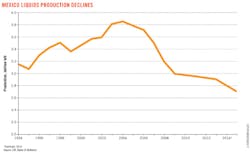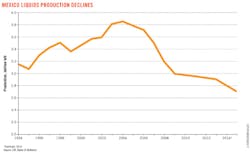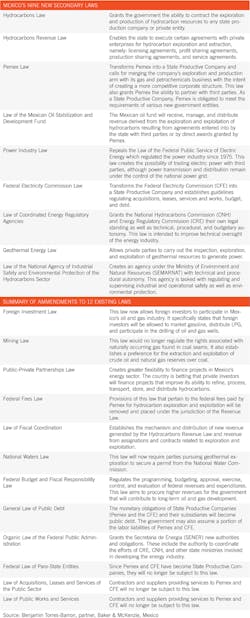Natalie Regoli
Brian Polley
Baker & McKenzie LLP
Houston
With one third of the Mexican government's budget funded by Petróleos Mexicanos (Pemex), a decline in the state-owned oil company's production hits the government hard. Over the last decade, insufficient operational capabilities, lack of capital, and maturation of the once abundant Cantarell field and Chicontepec basin have dropped production. Last year, output totaled 2.9 million b/d of crude oil and other petroleum liquids, a 25% decline from the country's 2004 high of 3.85 million b/d.
As of April 2014, Mexico's crude oil production, which comprises about 85% of its total liquids production, fell to a monthly average of 2.5 million b/d, its lowest level since 1994 (see figure). By comparison, Texas is expected to produce more than 2.7 million b/d in 2014, and production for the entire US reached 8.4 million b/d in July, up from 6.5 million b/d in 2012. Mexico's petroleum trade balance with the US is now negative for the first time in at least 40 years, and Pemex is discussing importing oil from the US for refining and using US companies to manage that refining, according to Pemex Chief Executive Officer Emilio Lozoya.
Mexico is the tenth biggest crude oil producer in the world and a strategic non-OPEC source of oil for the US as its third largest supplier. Colombia's successful oil liberalization of 2003 is a recent example of how energy reform can almost double production in just a few years. In order for reform to work in Mexico after the failed 2008 attempt under President Felipe Calderón, the Peña Nieto administration had to act boldly to incentivize foreign investment. It did so by amending 12 existing laws and creating nine new secondary laws, opening Mexico's oil, gas, and electricity sectors to foreign and private investment for the first time since 1938 (see table). The US Energy Information Administration estimates that Mexico holds approximately 545 tcf of technically recoverable shale gas reserves, and is the sixth largest shale gas reserve holder in the world.
The players
Mexican government officials expect crude production to increase to at least 2.8 million b/d in 2018 from today's levels due to the suite of new and amended laws, but effective implementation will be critical. At the Cabinet level, here are the key departments:
• Ministry of Finance and Public Credit (Secretaría de Hacienda y Crédito Público, SHCP). SHCP will bear primary responsibility for deciding or negotiating fiscal terms for each contract type and designing the Mexican Petroleum Fund for Stabilization and Development (Fondo Mexicano del Petróleo para la Estabilización y el Desarrollo). This will be a sovereign wealth fund with primary responsibility for the national oil income.
• Ministry of Energy (Secretaría de Energía, SENER). SENER will remain the key ministry of the energy sector and continue to establish energy policy. It will also decide which fields will be open for exploration and production by private companies, determine technical and financial requirements for bidders, and determine which contract types will be awarded.
• Ministry of Environment and Natural Resources (Secretaría de Medio Ambiente y Recursos Naturales, SEMARNAT). With the goal of encouraging sustainable development, this ministry is tasked with the mission of protecting, conserving, and restoring the natural resources, assets, and environmental services of Mexico.
Two regulators will oversee the oil, gas, and electricity sectors:
• National Hydrocarbons Commission (Comisión Nacional de Hidrocarburos, CNH). This commission will be more robust and the most important regulatory body. It will focus on the upstream sector. It will oversee regulation; run public tenders according to the rules established by SENER and SHCP; oversee the bidding process; name the winning bidder of the each tender; and oversee seismic and geological studies.
• Energy Regulatory Commission (Comisión Reguladora de Energía, CRE). This commission will now be independent, hold more power, and regulate the electricity, midstream, and downstream sectors.
The two operating companies of importance remain the same. Pemex is the 76-year-old, state-owned oil company. The Federal Electricity Commission (Comisión Federal de Electricdad, CFE) is the 77-year-old, state-owned utility company. Three entities will be created to help implement the reform:
• National Agency for Industrial Safety and Environmental Protection (Agencía Nacional de Seguridad y Protección al Medio Ambiente del Sector Hidrocarburos, ANSIPA). It will regulate and oversee environmental and safety issues, and operate under SEMARNAT.
• National Center for Natural Gas Control (Centro Nacional de Control de Gas Natural, CENEGAS). It will operate the state-owned natural gas pipelines and storage facilities.
• National Center for Energy Control (Centro Nacional de Control de Energía, CENACE). It will operate the state-owned electricity grid.
The opportunities
Of all the potential opportunities for foreign and private firms created by the reform, four upstream areas hold the most promise: exploration and production; supply chain and supply chain management; infrastructure development; and financing and private equity.
On Aug. 13, 2014, the Mexican government assigned certain fields to Pemex in a non-competitive bid round. Pemex was granted four packages of fields in Round Zero. These contained: mature fields; fields with extra-heavy crude oil; two deepwater gas fields with 212 MMboe in proved and probable reserves near the 2007 Lakach discovery; and two partnerships to develop the ultradeepwater Perdido Fold Belt.
The highly anticipated Round One, in which the government will competitively tender over 150 blocks to private companies and Pemex, is scheduled to be held by mid-2015.
Exploration and production in shale formations and in the Gulf of Mexico will require a tremendous expansion of the supply chain for oil field services equipment. Housing, water, and pipeline infrastructure must also be expanded to facilitate shale development. Some observers have predicted $34 billion or more in pipeline investment will be required over the next several years to transport growing production.
Mexico is also increasing its reliance on natural gas as a fuel for power generation, and more pipelines will be needed to satisfy this demand. Estimates vary, but it is likely that around 55 Gw of additional power generation capacity will be needed over the next few years which, for comparison's sake, equals roughly the total generating capacity of the largest US electricity utility.
Unconventional resource development also requires substantial investment in roads. This is apparent in the Texas Eagle Ford shale, where rural county roads deteriorate rapidly under the strain of heavy truck traffic. Substantial opportunities exist in the planning, financing, and construction of the requisite road infrastructure needed to support oil and gas development.
Finally, and perhaps most obviously, the Mexican energy reform's welcoming of foreign investment offers opportunities for financing and private equity. Though some of the largest exploration and production projects will be self-financed by majors and their large balance sheets, smaller participants are already using private equity firms to back new ventures in Mexico. These ventures are typically focused on oil and have an extended exit timeline to account for the rapidly evolving regulatory environment.
Mexico is experiencing a historic shift. Pemex is unable, both operationally and financially, to fully develop the county's vast reserves and reverse its declining production. The company estimates $60 billion/year is needed for development and last year invested just $26 billion. As a result, the Peña Nieto administration is now opening the energy sector to private investment for the first time in nearly eight decades. Legislation is in place, the nuances of its implementation are unfolding, and now is the ideal time for international investors to seek Mexican partners and capitalize on the opportunity.
The authors
Natalie Regoli ([email protected]) is a partner in Baker & McKenzie's Houston office and works with Baker & McKenzie's five Mexico offices to assist companies with entering Mexico and navigating the government tender process. Regoli has experience with oil and gas projects along with petrochemical projects. Her project work focuses on development; financing; engineering, procurement, and construction; and claims and dispute resolution for energy and infrastructure construction projects. She has worked with governmental units, project sponsors, shareholders, investment bankers, credit rating agencies, commercial bankers, and corporate trustees.
Brian Polley ([email protected]) is an associate in Baker & McKenzie's Houston office and advises on energy mergers and acquisitions, along with private equity transactions and project development in the US, Latin America, and around the world. Polley also advises clients on LNG projects as well as national security reviews of foreign investments (CFIUS).


